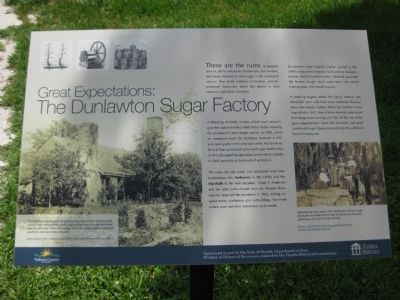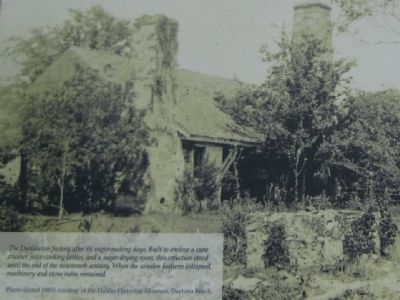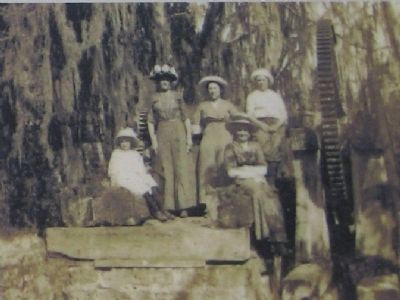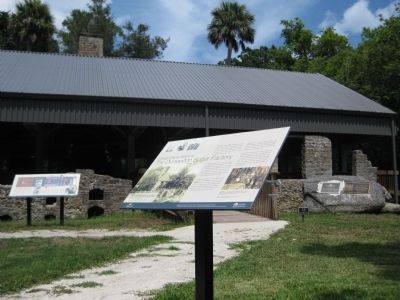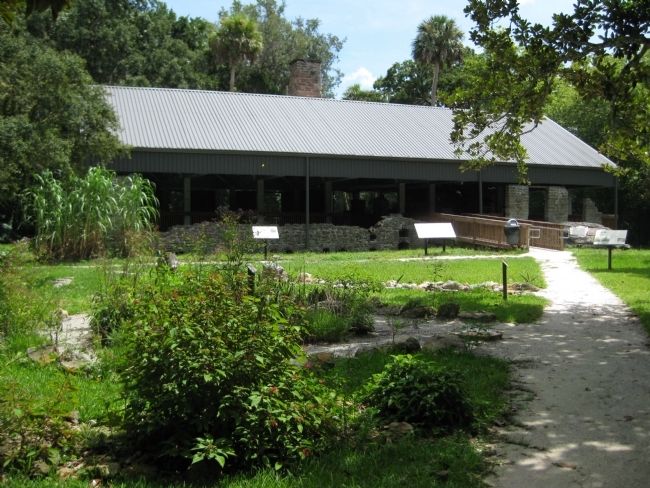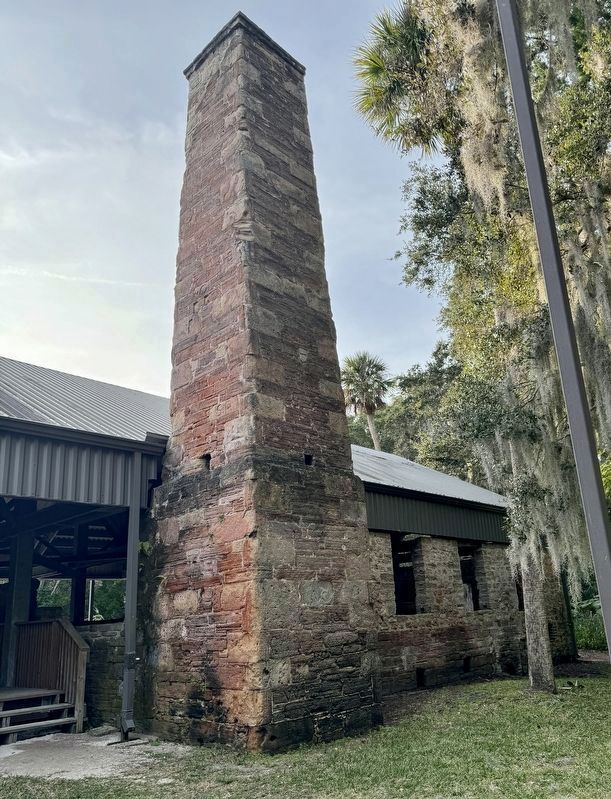Port Orange in Volusia County, Florida — The American South (South Atlantic)
The Dunlawton Sugar Factory
Great Expectations:
Inscription.
These are the ruins of people's dreams, left by successive landowners, free workers, and slaves. Hoping to make sugar in the nineteenth century, they faced isolation, hurricanes, and dispossessed Seminoles. Some lost money in their ventures, and others lost more.
A blending of family names - Dunn and Lawton - gave this spot its familiar label in the 1830s. Actually, the plantation's story began earlier, in 1804, when an immigrant from the Bahamas received a 995-acre land grant on the west side of the Halifax River. Patrick Dean produced cotton and sugar, but the War of 1812 disrupted his operations and he died violently in 1818, possibly at the hands of an Indian.
The ruins we see today are associated with later landowners: the Andersons in the 1830s and the Marshalls in the next decades. Sarah P. Anderson and her sons (who moved from the Tomoka River country) acquired the plantation in 1832, adding coquina works, machinery, and outbuildings. Seminole raiders soon sent that investment up in smoke.
Dunlawton's next hopeful planter arrived in the 1840s along with a skeptical wife and her energetic brother. South Carolinian John J. Marshall expanded the factory, bought more equipment, and started making sugar, with mixed success.
A stunning tragedy ended this family venture, but Marshall's own wife had never harbored illusions about the Florida frontier. When her brother's cane crop failed in 1851, Maria Hawes Marshall announced that things were turning out "like all the rest of his great expectations." Soon the Marshalls had gone and the old sugar house was evolving into a different kind of fantasy site.
[ Photo ]
The Dunlawton factory after its sugar-making days. Built to enclose a cane crusher, juice-cooking kettles, and a sugar-drying room, this structure stood until the end of the nineteenth century. When the wooden features collapsed, machinery and stone ruins remained.
Photo (dated 1885) courtesy of the Halifax Historical Museum, Daytona Beach.
[ Photo ]
Exploring the ruins, about 1900. Dunlawton's life as a sugar plantation was much shorter than its time as a community gathering point and a Florida curiosity.
Photo courtesy of the Port Orange Historical Trust/Harold and Priscilla Cardwell.
Sponsored in part by the State of Florida, Department of State, Division of Historical Resources, assisted by the Florida Historical Commission.
Erected by Volusia County and the State of Florida, Department of State, Division of Historical Resources, assisted by the Florida Historical Commission.
Topics. This historical marker is listed in these topic lists: Agriculture • Industry & Commerce • Settlements & Settlers • Wars, US Indian. A significant historical year for this entry is 1804.
Location. 29° 8.47′ N, 81° 0.351′ W. Marker is in Port Orange, Florida, in Volusia County. Marker is on Old Sugar Mill Road east of Herbert Street, on the right when traveling east. The marker is on the grounds of the Dunlawton Sugar Mill Botanical Gardens. Touch for map. Marker is at or near this postal address: 950 Old Sugar Mill Road, Port Orange FL 32129, United States of America. Touch for directions.
Other nearby markers. At least 8 other markers are within walking distance of this marker. Sugar Making (here, next to this marker); Dunlawton's Building Blocks (a few steps from this marker); The Most Dangerous Chieftain (a few steps from this marker); From the Boardwalk (a few steps from this marker); Spanish Mills and Bongoland (a few steps from this marker); Telling Dunlawton's Stories (a few steps from this marker); Living on the Edge (a few steps from this marker); The Roof (within shouting distance of this marker). Touch for a list and map of all markers in Port Orange.
More about this marker. The marker features diagrams of the following:
• sugar canes
• mill machinery
• shipping barrels
The marker also features the logos of Volusia County and the Florida Heritage program.
Regarding The Dunlawton Sugar Factory. As noted by the marker, the name of Dunlawton originated from merging "Dunn" and "Lawton". "Dunn" was Sarah Anderson's maiden name, while "Lawton" was the name of the family from whom the Andersons bought the plantation. Sarah Anderson came from the Tomoka Plantation (in north Volusia County), which she inherited from her mother. After her husband died, she and her sons sold the Tomoka property and bought the old Patrick Dean plantation from Charles and Joseph Lawton.
The site was listed with the National Register of Historic Places in 1973 under the name Dunlawton Plantation--Sugar Mill Ruins (# 73000606).
Related markers. Click here for a list of markers that are related to this marker. To better understand the story of the Dunlawton Plantation and Sugar Mill Ruins, study each marker in the order shown.
Credits. This page was last revised on January 8, 2024. It was originally submitted on August 26, 2011, by Glenn Sheffield of Tampa, Florida. This page has been viewed 1,001 times since then and 49 times this year. Photos: 1. submitted on August 26, 2011, by Glenn Sheffield of Tampa, Florida. 2, 3. submitted on August 27, 2011, by Glenn Sheffield of Tampa, Florida. 4, 5. submitted on August 26, 2011, by Glenn Sheffield of Tampa, Florida. 6. submitted on January 8, 2024, by Brandon D Cross of Flagler Beach, Florida. • Bill Pfingsten was the editor who published this page.
